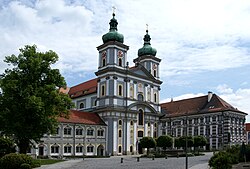Waldsassen Abbey
| Abtei Waldsassen | |

The basilica of Waldsassen
|
|
| Monastery information | |
|---|---|
| Order | Cistercian |
| Established | 12th century 1863 |
| Disestablished | 1803 |
| Site | |
| Location | Waldsassen, Germany |
| Coordinates | 50°0′14″N 12°18′34″E / 50.00389°N 12.30944°ECoordinates: 50°0′14″N 12°18′34″E / 50.00389°N 12.30944°E |
| Public access | partial |
| Imperial Abbey of Waldsassen | ||||||||||
| Reichsabtei Waldsassen | ||||||||||
| Imperial Abbey of the Holy Roman Empire | ||||||||||
|
||||||||||
| Capital | Waldsassen | |||||||||
| Government | Theocracy | |||||||||
| Historical era | Middle Ages | |||||||||
| • | Abbey founded | 1128–32 | ||||||||
| • | Gained Reichsfreiheit | 1147 | ||||||||
| • |
Mediatised to Electorate of the Palatinate |
1543 | ||||||||
| • | Secularised to Bavaria | 1803 | ||||||||
|
||||||||||
Waldsassen Abbey (German: Abtei Waldsassen) is a Cistercian nunnery, formerly a Cistercian monastery, located on the River Wondreb at Waldsassen near Tirschenreuth, Oberpfalz in Bavaria, Germany, close to the border with the Czech Republic. In the Holy Roman Empire it was an Imperial Abbey.
The monastery, the first Cistercian foundation in Bavaria, was founded by Gerwich of Wolmundstein, a Benedictine monk of Sigeberg Abbey, with the permission of his former abbot Kuno, then Bishop of Regensburg, and built between 1128 and 1132. The original community was sent to Waldsassen from Volkenroda Abbey in Thuringia, of the line of Morimond Abbey.
The first abbot was elected in 1133, making this one of the earliest Cistercian foundations.
Soon the abbey became one of the most renowned and powerful of the times. As the number of monks increased, several important foundations were made at Sedlitz and Ossegg in Bohemia, at Walderbach, near Regensburg, and in other places. In 1147, Conrad III, King of Germany, granted it reichsunmittelbar status, making it an Imperial abbey. Several of its thirty-seven abbots up to the Reformation were noted for sanctity and learning; of them, Herman, the seventh abbot, and John, the seventeenth, as well as Gerwich, its founder, and Wigand, the first prior, are commemorated in the menology.
...
Wikipedia


